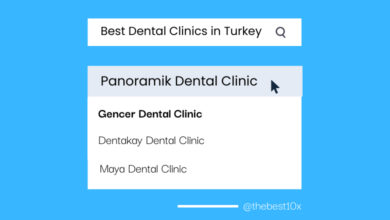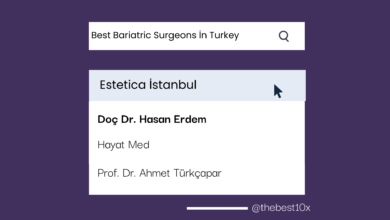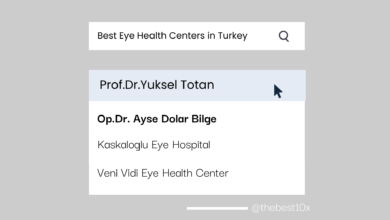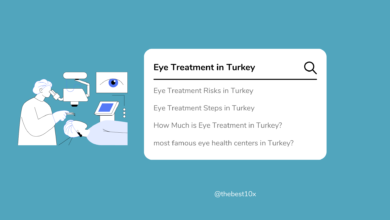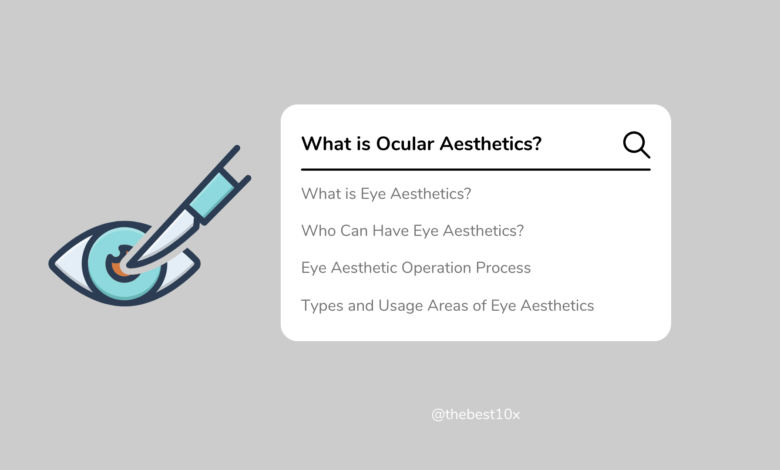
As eye aesthetics become accessible to more people, many people are exploring this rapidly growing area to address aesthetic issues around the eyes. Eye aesthetic procedures can revitalize one’s facial expression, reduce the signs of aging and sometimes make one’s appearance more energetic and dynamic. Although eye aesthetics offer fascinating results, it is important to research well and consult with a qualified plastic surgeon before deciding on this type of procedure. In this article, you will learn more about the types of eye surgery, the steps and what to look out for.
What Is Eye Aesthetics?
Eye aesthetics is the general name for surgical or non-surgical procedures performed to correct aesthetic problems around the eyes or to make the eyes look younger and fresher. These aesthetic procedures can address problems such as drooping eyelids, puffiness, drooping eyebrows, wrinkles around the eyes or bags under the eyes. Eye aesthetics are commonly used to revitalize one’s facial expression and restore a sense of youthfulness. These procedures can be performed as surgical interventions (blepharoplasty, brow lift) or non-surgical procedures (under-eye fillers, botox) and can be customized depending on the person’s wishes and needs.
What Are The Purposes Of Eye Aesthetics?
Eye aesthetics or eyelid aesthetics is a commonly preferred plastic surgery procedure to correct aesthetic problems around the eyes and make the eyes look younger and more vibrant. These procedures are used to revitalize a person’s facial expression and reduce the signs of aging.
Here are the main aims of eye aesthetics:
- Rejuvenation of the Eyelids: Sagging or swollen upper or lower eyelids can make a person look old or tired. Eyelid aesthetics corrects these problems and gives the eyes a younger and more dynamic appearance.
- Removal of Under Eye Bags: Under-eye bags can make a person look tired or sick. Eye aesthetics aims to achieve a fresher appearance by reducing under-eye bags.
- Brow Lift: Sagging eyebrows can give the eye area an aged appearance. The brow lift procedure aims to make the eyes look more open and lively by lifting the eyebrows upwards.
- Natural and Harmonic Results: Eye aesthetic specialists aim to achieve aesthetically pleasing results by mimicking natural hair growth patterns and angles during the procedure. This ensures that the person’s post-procedure appearance is natural and harmonious.
- Increasing Self-confidence: Eye aesthetics can improve self-confidence by solving aesthetic problems around the eyes. A younger and more vibrant appearance can help a person regain self-confidence.
Eye aesthetics is an effective option for many people who want to improve their quality of life and regain a sense of youth. However, it is important to consult with an expert plastic surgeon when deciding on these procedures, as each patient’s needs are different and a personalized approach may be required.
Who Can Have Eye Aesthetics?
Eye aesthetics offer an effective solution for many people who want to eliminate aesthetic problems around the eyes or achieve a more youthful and vibrant appearance. However, this procedure may not be suitable for everyone. Here is detailed information about suitable candidates and unsuitable candidates for eye aesthetics:
| Status / Criteria | Eligible Candidates | Ineligible Candidates |
Aesthetic Concerns | People with aesthetic problems such as eyelid sagging, swelling, wrinkles or under-eye bags | People who are satisfied with their eye and eye contour appearance |
Functional Problems | Eyelid drooping | – |
Age Factor | People who develop aesthetic problems around the eyes due to genetic factors or aging | Children with incomplete body development, persons under 18 years of age |
Health Status | People who do not have a health condition that may prevent surgery | People who have a health problem that will prevent surgery |
Eye aesthetics should be evaluated depending on the individual needs and health status of the person. Every patient is different, so it is important to consult with a specialized plastic surgeon. The surgeon will assess the person’s condition and create an appropriate treatment plan.
Eye Aesthetic Operation Process
Eye aesthetic surgery is a popular option for many people who want to correct aesthetic problems around the eyes or achieve a more youthful and vibrant appearance. This operation is performed by a specialized plastic surgeon through a carefully planned process that includes the following steps:
Pre-Operational Consultation and Evaluation Process
Before undergoing eye aesthetic surgery, patients have a detailed consultation with a specialist plastic surgeon. At this stage, the surgeon evaluates the aesthetic problems around the patient’s eyes, understands the patient’s expectations and creates a personalized treatment plan.
Anesthesia Application
On the day of the operation, the patient is usually given a local anesthetic. This ensures that the patient does not feel pain or discomfort during the operation. In some cases, general anesthesia may be preferred.
Eyelid Aesthetics (Blepharoplasty)
The main stage of the eye aesthetic operation is known as eyelid aesthetics. This stage involves correcting sagging or swelling of the upper and lower eyelids. Excess skin and fatty tissue are removed, muscles are organized and stitches are removed.
Brow Lift (Frontoplasty)
Aesthetic problems around the eyes may be associated with sagging eyebrows. Therefore, a brow lift may also be required. At this stage, the eyebrows are lifted upwards, making the eyes look more open and lively.
Recovery and Consequences
After the operation, the healing process required for the patient’s eye aesthetic area begins. Swelling and bruising are normal in the first few days, but decrease over time. The results usually become fully visible within a few months and allow the person to achieve a younger and fresher appearance.
Eye aesthetic surgery is an effective option for many people who want to increase their self-confidence and regain their sense of youth. However, each patient’s situation is different, so consultation and evaluation with a specialized surgeon before the operation is important. In addition, the post-operative care instructions given by the doctor should be followed meticulously.
Types and Usage Areas of Eye Aesthetics
Eye aesthetics includes a range of surgical and non-surgical procedures performed with different methods to correct aesthetic problems around the eyes or to make the eyes look younger and more vibrant. These various methods are preferred depending on the patient’s needs and aesthetic goals. Here are the types of eye aesthetics and their usage areas:
Blepharoplasty (Eyelid Aesthetics)
Blepharoplasty, also known as eyelid surgery, is used to correct sagging or swelling of the upper and lower eyelids. This procedure is performed to reduce the signs of aging around the eyes and make the eyes look younger and more dynamic. It can also open up the visual field and provide functional improvement.
Brow Lift (Frontoplasty)
A brow lift aims to remove sagging eyebrows and give the eyes a more open appearance. This procedure is suitable for people who want to remove signs of aging around the eyes or correct the natural position of the eyebrows.
Under Eye Filler
Under-eye fillers are used to reduce under-eye bags or dark circles and make the eye area look younger and fresher. This non-surgical procedure is applied to the under-eye area using fillers.
Botox Injections
Botox injections are used to reduce wrinkles around the eyes and prevent sagging eyebrows. Botox reduces the signs of aging by causing muscles to relax temporarily.
Eyelid Lift (Ptosis Surgery)
An eyelid lift is used when the upper eyelid is drooping or drooping. This procedure opens up the patient’s field of vision and aims to achieve aesthetic results.
The methods of eye aesthetics are determined by the individual needs and aesthetic goals of each patient. An expert plastic surgeon assesses the patient’s condition and recommends the most appropriate procedure or combination of them. Eye aesthetics is an effective aesthetic solution that helps restore one’s sense of youth and increase self-confidence.
Care and Recovery Process After Eye Aesthetics
Careful care and recovery after eye aesthetic surgery is critical to achieve successful results and prevent any complications.
Here is what you need to know in the period after eye aesthetics:
Early Days
Immediately after the operation, protection is provided with bandages and gauze dressings applied around the eyes. During the first 24 hours, you should keep your head in a lying position. This helps to reduce swelling and bruising.
Swelling and Bruises
Swelling and bruising around the eyes are normal in the period after eye aesthetic surgery. These symptoms usually subside within a few days. You can relieve swelling by using cold compresses.
Pain and Discomfort
A slight pain or discomfort after the operation is normal. You can relax by regularly using painkillers recommended by your doctor.
Bandages and Stitches
You should maintain the bandage and stitches applied around the eye area for the time specified by your doctor. These bandages and stitches support the healing process.
Eye Care
You should take care of your eyes according to your doctor’s recommendations. You may need to use special eye drops or ointments. If you wear contact lenses, you can wear them again with your doctor’s approval.
Recreation and Activities
In the post-operative period, you should avoid excessive physical activity and focus on rest. Avoid heavy exercise to protect your eyes.
Doctor Checks
Regularly attending the appointments scheduled by your doctor will ensure that the healing process is monitored. You should follow your doctor’s instructions carefully.
Sun Protection
It is important to take care to protect from the sun in the postoperative period. You can protect your eyes from UV rays by wearing sunglasses.
Frequently Asked Questions
At what age can I have eye aesthetics?
There is no definite age limit for eye aesthetics. It is generally preferred as the signs of aging become evident around the eyes. However, there are suitable candidates at any age. You can determine your suitability by consulting a plastic surgeon.
How long does eye aesthetics take?
The eye aesthetic procedure usually takes 1 to 2 hours. The duration may vary depending on the complexity of the procedure and the amount of corrections to be made.
Is the result of eye aesthetics permanent?
Eye aesthetic results are long-lasting, but the effects of aging can reappear over time. Results may vary depending on the person’s lifestyle, genetic factors and skin type.
Does eye aesthetics hurt?
Eye surgery is usually performed under local anesthesia or sedation, so pain sensation during the procedure is minimal. There may be pain and discomfort after the procedure, but this is usually manageable.
Will there be a scar after eye aesthetics?
Eye aesthetic scars tend to be minimal and usually diminish during the healing process. When appropriate surgical techniques are used, scars can become invisible.
Eye aesthetics is a type of plastic surgery that greatly affects the appearance of the person. Therefore, the choice of a surgeon is of critical importance for eye aesthetics. Choosing a suitable surgeon ensures that the desired results are achieved and the risk of possible complications is minimized. An experienced and expert plastic surgeon understands the specific needs and goals of the person, makes a personalized surgical planning and performs the surgery in the safest way. When choosing a surgeon, you should carefully consider their references, experience and success stories. This is a critical decision that will help you increase your satisfaction after surgery. The outcome of eye aesthetic surgery is directly related to the surgeon’s skills and experience, and therefore it is very important to research the best eye aesthetic doctors before the procedure and make sure you choose the right one.

